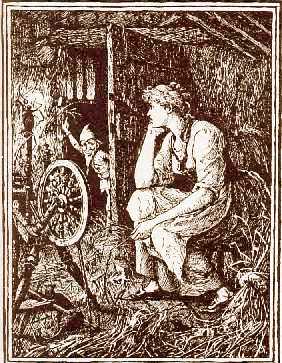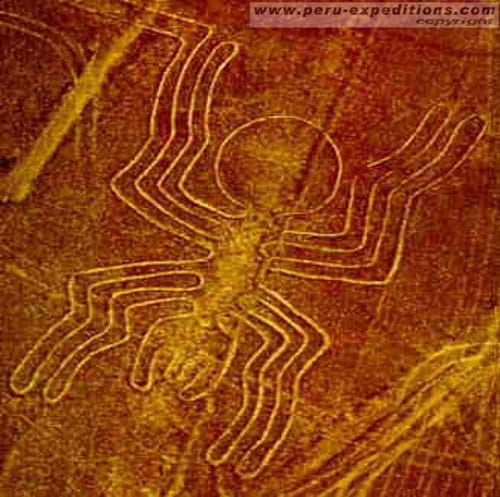Quick Look
Grade Level: 6 (5-7)
Time Required: 1 hours 45 minutes
(two 50-minute sessions)
Expendable Cost/Group: US $0.00
Group Size: 2
Activity Dependency: None
Subject Areas: Physical Science, Physics

Summary
In a spin-off to studying about angular momentum, students use basic methods of comparative mythology to consider why spinning and weaving are common motifs in creation of myths and folktales. Note: The literacy activities for the Mechanics unit are based on physical themes that have broad application to our experience in the world — concepts of rhythm, balance, spin, gravity, levity, inertia, momentum, friction, stress and tension.Engineering Connection
Since the days of hand spinning wheels and weaving looms, the modern textile industry has become highly mechanized for mass production with the use of engineer-designed equipment. The textile industry is also continually evolving with the engineering of creative materials — micro fibers, high-tech fibers and polymeric structures — that provide special characteristics such as vapor-humidity transmission, liquid-humidity transmission, air permeability, static electricity or thermal properties, for use in everything from rain jackets to cleaning up oil spills to medical surgery.
Learning Objectives
After this activity, students should be able to:
- Apply skills in analysis, synthesis, evaluation and explanation to their writing and speaking.
- Write and speak in the content areas using the technical vocabulary of the subject accurately.
- Relate the concepts of spinning and weaving in an engineering context.
Educational Standards
Each TeachEngineering lesson or activity is correlated to one or more K-12 science,
technology, engineering or math (STEM) educational standards.
All 100,000+ K-12 STEM standards covered in TeachEngineering are collected, maintained and packaged by the Achievement Standards Network (ASN),
a project of D2L (www.achievementstandards.org).
In the ASN, standards are hierarchically structured: first by source; e.g., by state; within source by type; e.g., science or mathematics;
within type by subtype, then by grade, etc.
Each TeachEngineering lesson or activity is correlated to one or more K-12 science, technology, engineering or math (STEM) educational standards.
All 100,000+ K-12 STEM standards covered in TeachEngineering are collected, maintained and packaged by the Achievement Standards Network (ASN), a project of D2L (www.achievementstandards.org).
In the ASN, standards are hierarchically structured: first by source; e.g., by state; within source by type; e.g., science or mathematics; within type by subtype, then by grade, etc.
International Technology and Engineering Educators Association - Technology
-
Explain how various relationships can exist between technology and engineering and other content areas.
(Grades
3 -
5)
More Details
Do you agree with this alignment?
Materials List
- Paper and pencils
- MythQuester Myth Log, one per student
- MythQuester Mind Map Worksheet, one per student
- Access to the Internet
Worksheets and Attachments
Visit [www.teachengineering.org/activities/view/cub_mechanics_lesson08_activity2] to print or download.Introduction/Motivation
Remember the tale of Rumpelstiltskin? In the story, a miller brags to the king that his daughter can spin straw into gold. With the aid of a gnome, she is able to spin a roomful of flax on each of three successive nights. But there's a price to pay to the gnome each night — first a necklace, then a ring and lastly, the promise that she will give her first-born child to the little man. The miller's daughter desperately agrees to the final terms, thinking the terrible outcome is a remote possibility. But the king is so impressed with her gold-spinning that he marries her and makes her his queen. A year later they have a child. Suddenly the gnome appears to claim his reward. The queen is horrified and the little man takes pity on her tears. He gives her three days to guess his name. If she cannot, she must forfeit the child. She sends a messenger through the land who eventually overhears the little man reveal his secret. On the third day, the queen astonishes the gnome by pronouncing his name, Rumpelstiltskin. The balance of power shifts and she keeps her child.

This is a charming tale. Perhaps when you were younger you even found it a little frightening. Did you ever wonder why things in this tale (and many others) come in threes: three rooms of flax, three gifts, three days and three attempts to guess Rumpelstiltskin's name? And, what do you suppose is behind the magic of spinning flax into gold? And, why such an odd task — guess a name and you keep your child? What's in a name?
In this activity you will find answers to these and many other questions about fairy tales and myths, possible answers because the meaning of such tales is always a matter of interpretation. That is the beauty of myth. There are many versions of individual myths and folktales, created over centuries by many tellers. In this sense, myths and legends are communal artifacts. At the same time, these tales speak to a profound depth within each of us as individual members of a larger community and may be individually interpreted.
The study of parallels between cultures as expressed in common mythical themes is called comparative mythology. Keep in mind, however, that it is easy to get carried away when making comparisons. Parallels between myths can be striking and can reveal our essential humanness, but cultures should be respected as the unique expression of the human beings who participate in those cultures.
Procedure
In Mechanics unit, Lesson 8, students learned about the principle of angular momentum, in other words, "spin." The title of that lesson, "Ring around the Rosy," from the familiar nursery rhyme, has suggested the theme of this literacy activity. Students will be directed to inquisitively search online, i.e. go on a WebQuest, to explore themes of spinning in world mythology.
As Bruno Bettleheim and Marie-Louise von Franz made clear, fairy tales are not just for children. "Ring Around the Rosy," the simple but enigmatic little rhyme —"Ring around the rosy,/ Pocket full of posies./ Ashes, ashes,/ We all fall down!" — has been linked to the Black Death of the 14th century, the Great Plague of London in 1665 and to Shiva, the Hindu destroyer deity, and the dance of reincarnation! (Source: Richard Stoney's "Ring around the Rosy" and Shiva website, http://richston100.tripod.com/rosy.html)
Preteens who have moved beyond the stage of magic and wonder and are beginning to think analytically may no longer be captivated by fairy tales. But, they are still likely to take an interest in a comparative study of common themes in myths, legends and folktales — to learn why these stories are told, adapted and retold in our ongoing effort to make sense of the world. In the process, they discover that ancient myths are still relevant to their contemporary experience.
So we will spin a tale about "spin" and consider why tales of spinning and weaving are popular the world over: Native American tales of the trickster spider, the spider woman and benevolent Grandmother Spider who spun the world out of herself and bestowed wisdom and a knowledge of the arts upon her creatures; African tales of the wise and lovable trickster spider, Anansi; Greek myths of Arachne, the weaver, who was transformed into a spider because of her vain pride in craftsmanship, and the Three Fates, who spun human destiny; their northern counterparts, the Norns, spinners also; European tales of Sleeping Beauty, The Three Spinners, The Gold Spinners, Rumplestiltskin, and Mother Holle; and the ancient-modern myth of the web-spinning super-hero, Spider Man; as well as the charming modern take on magical spider legends, Charlotte's Web.
Observing
Go on a WebQuest by searching online to learn as much as you can about Rumplestiltskin. One way to gain insight on this tale, in which the art of spinning plays a prominent role, is to compare it with other tales that feature spinning and the related activity of weaving. To help you get started on this research and background reading, use some of the following links:
- https://www.cs.cmu.edu/~spok/grimmtmp/044.txt
- https://www.dltk-teach.com/fairy-tales/rumpelstiltskin/story.htm
- https://en.wikipedia.org/wiki/Rumpelstiltskin
As you begin your WebQuest using a search engine, such as Google, here are a few keyword suggestions. Remember that when you type keywords into Google, it is generally best to narrow your search by using more than one term. For example, "spinning" by itself is not enough; combine "spinning" with "myth" or "legend." Same with "spider"; combine it with other terms to pinpoint folktales about spiders. You might also try an ethnic term such as "Native American" or "African" along with other relevant keywords. You might also try "dreamcatcher" and "Maypole." For spider legends try "grandmother spider" or "Anansi."
Hint: Remember to put quotation marks around two terms that go together, such as "grandmother spider." Otherwise, you will retrieve many individual sites about grandmothers and about spiders, rather than specific legends.
Thinking
As you collect stories about spiders and Maypoles and dreamcatchers, and the acts of spinning and weaving in the world, keep track of the tales and their central motifs on the MythQuester Myth Log. Jot down possible interpretations, and get ready to write your own myth or modern fairy tale.
In preparation for their own writing, have students analyze the elements they recorded in their myth log: Create a mind map as a way to compare story elements found in two or more folktales or myths. Look for elements that the stories have in common or that are unique to each story, and draw your mind map on the MythQuester Mind Map Worksheet. (A mind map is a non-linear, highly-developed branching form of note taking. See the MythQuester Mind Map Teacher's Sheet for an example mind map. For more information, see the Notetaking information at Leeds University, https://library.leeds.ac.uk/downloads/download/39/note_taking_or_note_making.)
Writing
Write your own "spider" story and present it to the class, either by taking on the role of storyteller yourself or acting out the story with your classmates.
Vocabulary/Definitions
Artifact: A product of human conception or agency.
Comparative mythology: The study of myths that seeks to identify common elements and universal themes.
Motif: A recurrent thematic element in an artistic or literary work.
WebQuest: An inquiry-oriented lesson format in which most or all the information that learners work with comes from the web.
Assessment
Pre-Activity Assessment
Brainstorming: The suggestions students offer as they brainstorm keywords for a Google search indicate to what extent they have understood the topic.
Activity Embedded Assessment
Logs & Worksheets: Review students' MythQuester Myth Logs and Mind Map Worksheets for thoroughness and to gauge their understanding of the assignment.
Post-Activity Assessment
Expressive Writing: Evaluate the students' spider stories in terms of creativity, humor, writing style and grammatical correctness. Students may also perform their tales and be evaluated on how well they captivate their audience.
Troubleshooting Tips
For students of this age, it is a good idea to introduce the topic of myth as a sophisticated "analytical" concept, because some may think they are too "grown up" for fairy tales.
Plan on one 50-minute class for the online search/WebQuest and one 50-minute class to discuss findings and prepare for writing.
Activity Extensions

Find out how spiders actually do spin their webs. Report your findings to the class.
The mysterious Nazca lines were constructed around 200 B.C. on a high desert plateau about 200 miles south of Lima, Peru. No one knows their purpose for certain. The gigantic shapes, one of which is the spider in the accompanying photograph, are only visible from the air. Go on a WebQuest to see what you can learn about the Nazca lines. Hint: Watch out for flying saucers. There is a more likely, but equally wonderful human explanation for the lines. Report your findings to the class.
Activity Scaling
- If some students have minimal experience with web research, it helps if the online search/WebQuest is a two-person team project.
Subscribe
Get the inside scoop on all things TeachEngineering such as new site features, curriculum updates, video releases, and more by signing up for our newsletter!More Curriculum Like This

Students learn the concept of angular momentum and its correlation to mass, velocity and radius. In an associated literacy activity, students use basic methods of comparative mythology to consider why spinning and weaving are common motifs in creation myths and folktales.
References
Bartleby.com: Great Books Online. Accessed May 15, 2004. (Online source for texts of folktales, myths and legends) http://www.bartleby.com/
Bettleheim, Bruno. The Uses of Enchantment: The Meaning and Importance of Fairy Tales. Vintage, 1989. (Classic Freudian interpreter)
Dictionary.com. Lexico Publishing Group, LLC. Accessed May 15, 2004. (Source of vocabulary definitions, with some adaptation) http://www.dictionary.com
The Internet's Sacred Text Archive. J.B. Hare. Accessed May15, 2004. (Online source for texts of folktales, myths and legends): http://www.sacred-texts.com/index.htm
Jenks, Kathleen. Mythology's Myth*ingLinks: Common Themes, East and West — Weaving: Arts & Lore (Cosmic Webs, Spinning, Spindles, etc.). Updated October 7, 2001. Department of Mythological Studies, Pacifica Graduate Institute. Accessed May 15, 2004. http://www.mythinglinks.org/ct~weaving.html
Project Gutenberg. Updated April 15, 2004. Ibiblio. Accessed May15, 2004. (Online source for texts of folktales, myths and legends) http://www.gutenberg.org/
Stoney, Richard. "Ring around the Rosy" and Shiva. Updated 1996. Accessed May 15, 2004. (A theory that the nursery rhyme is based on Hindu mythology) http://richston100.tripod.com/rosy.html
von Franz, Marie-Louise. The Interpretation of Fairy Tales. Updated 1996. Shambhala. (Classic Jungian interpreter)
White, E. B. Charlotte's Web. Harper Trophy, 1974.
Copyright
© 2004 by Regents of the University of Colorado.Contributors
Jane Evenson; Malinda Schaefer Zarske; Denise CarlsonSupporting Program
Integrated Teaching and Learning Program, College of Engineering, University of Colorado BoulderAcknowledgements
The contents of this digital library curriculum were developed under a grant from the Fund for the Improvement of Postsecondary Education (FIPSE), U.S. Department of Education, and National Science Foundation GK-12 grant no 0338326. However, these contents do not necessarily represent the policies of the Department of Education or National Science Foundation, and you should not assume endorsement by the federal government.
Last modified: August 4, 2020







User Comments & Tips